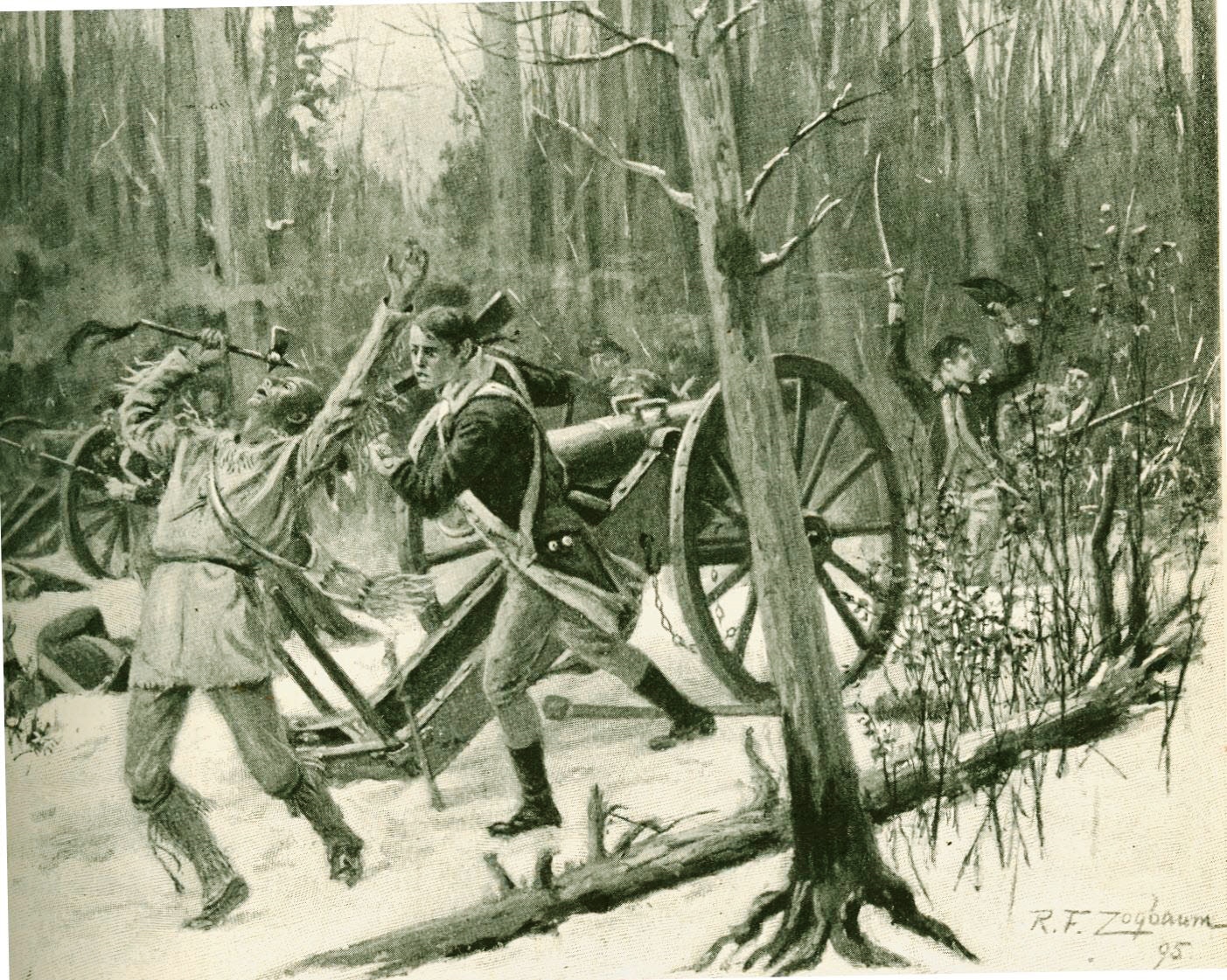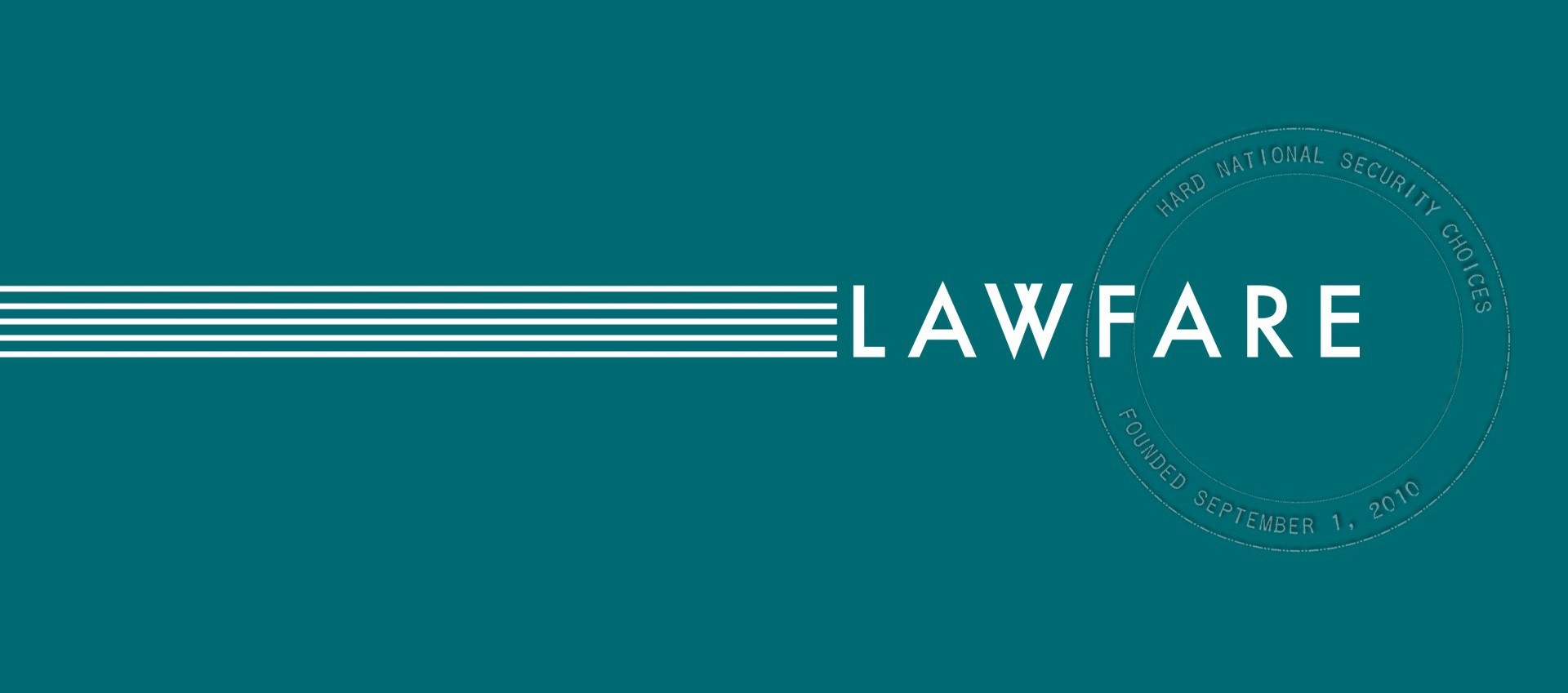Remembering St. Clair’s Defeat
Today is the anniversary of, by some measures, the U.S. military’s worst battlefield defeat ever. On Nov. 4, 1791, U.S. military forces, under the command of Northwest Territory Governor and U.S. General Arthur St. Clair, were routed by a confederacy of Native American tribes near the Wabash River in present-day Ohio. Although Indian Wars rarely feature much in discussions of constitutional war powers, they were among the most urgent threats facing the new republic. “St.

Published by The Lawfare Institute
in Cooperation With

Today is the anniversary of, by some measures, the U.S. military’s worst battlefield defeat ever. On Nov. 4, 1791, U.S. military forces, under the command of Northwest Territory Governor and U.S. General Arthur St. Clair, were routed by a confederacy of Native American tribes near the Wabash River in present-day Ohio. Although Indian Wars rarely feature much in discussions of constitutional war powers, they were among the most urgent threats facing the new republic. “St. Clair’s Defeat,” and the campaign in which it occurred, highlight some important ways in which the first president and Congresses exercised their respective powers to provide for the common defense.
The first significant military hostilities for the new United States began before the country was even established. In the years following the Revolutionary War, relations between Native Americans and U.S. settlers worsened in the Northwest Territory, a sparsely populated area beyond the Appalachian Mountains and between the Ohio River to the south and British Canada to the north. When the Constitution was ratified in 1789, violent encounters were growing more frequent and intense. Settlers and land speculators pressed the new national government to do something. In a September 1789 statute, Congress authorized about 700 federal “regulars”—troops that had already been raised by the Confederation Congress to help guard the frontier—and empowered the president to call into service parts of state militias, as he deemed necessary, “for the purpose of protecting the inhabitants of the frontiers… from the hostile incursion of the Indians.”
President Washington was unsure that United States forces would win on unfavorable turf, and his administration was distracted with putting in place the basic machinery of government. Washington sought to combine diplomacy with demonstrative threats of force, but through a series of failed operations and failed negotiations, the U.S. government slid deeper and deeper into a war for which it was not prepared.
This first military conflict involved an array of institutional actors just beginning to play their new constitutional roles. The president was at this time also the United States’s most experienced military commander—by far—and he favored a build-up of the regular, national army, but he was reluctant to appear too eager in flexing executive muscle. Congress needed to exercise the centralized military powers it had been granted, but it was uneasy about building a substantial national military force that would be financially costly and viewed widely as a rival to state militias—and a threat to republican government. Individual states bordering the Northwest Territory maintained their own poorly trained militia forces and were each reluctant to take on too large a share of burden.
The United States very nearly lost this first conflict. In 1790, General Josiah Harmar, a commander lacking experience fighting Native American forces, set off with about a thousand men, the vast majority of them state militia. When these forces suffered heavy losses and the Native American tribes refused to submit, Washington turned over command to Harmar’s superior, St. Clair. St. Clair was also ignorant of frontier combat with Native Americans, however, and although he now had about 3,000 men at his disposal—following added authorizations from Congress, boosting federal army forces to about 1,200 total—they again comprised mostly militia who were poorly trained, of weak morale, hungry and prone to desertion. St. Clair, suffering from painful gout, had to be carried around by stretcher.
In the critical battle on Nov. 4, 1791, most of St. Clair’s small and poorly trained forces were annihilated, and the rest fled. Writing in Harper’s Magazine about a century later, future president Teddy Roosevelt described the battle in rich detail:
Under cover of the smoke of the heavy but harmless fire from the army [the Indians] came up so close that they shot the troops down as hunters slaughter a herd of standing buffalo. Watching their chance, they charged again and again with the tomahawk, gliding in to close quarters, while their bewildered foes were still blindly firing into the smoke-shrouded woods. … There never was a wilder rout.
Following this massacre of St. Clair’s forces, including much of the regular army, the government escalated again in 1792. Now under new command, with a freshly organized 5,000-man army made up heavily of regulars, government forces overwhelmed the outnumbered and outgunned Native American confederacy. This victory provided short-term relief from frontier threats for U.S. settlers and cleared the way for further westward expansion.
Although in the end the United States won, this fitful and costly first military conflict exposed immediately some strains and ambiguities in the Framers’ constitutional compromises.
One issue was the president’s authority to launch military operations. Notably, the Justice Department’s Office of Legal Counsel (OLC) recently cited this episode to support a very expansive interpretation of presidential power to use military force without congressional authorization. In its 2018 memo justifying the president’s unilateral military action against Syria in response to chemical weapon use, OLC wrote:
Presidents have exercised their authority to direct military operations without congressional authorization since the earliest days of the Republic. President Washington directed offensive operations against the Wabash Indians in 1790. See David P. Currie, The Constitution in Congress: The Federalist Period, 1789–1801, at 84 (1997) (“[B]oth Secretary [of War] Knox and [President] Washington himself seemed to think [the Commander in Chief] authority extended to offensive operations undertaken in retaliation for Indian atrocities.”).
I welcome feedback from any readers who have studied the primary sources carefully—I’m still working my way through them—but I think OLC is wrong to emphasize this episode in justifying broad presidential power to initiate hostilities.
In fact, Washington looked to Congress to approve the campaign. He also returned to Congress during the fighting to confirm that he was acting pursuant to congressional authorization. Among other actions, Congress authorized this first small war through legislation approving federal troops, which were already engaged in fighting Native Americans based on authorizing resolutions from the pre-constitutional Confederation Congress, and also approving the president’s use of state militia for certain purposes, including protecting the frontiers against clashes with Native American forces.
True, Congress did not act through a formal declaration of war or with any specific set of approved actions, and Congress expressly authorized only defensive measures by state militias that the president could call into action. Also, at this time the president had few military resources at his disposal, so his raw ability to launch military campaigns without congressional approval was very limited. But the ensuing events—which involve direct protection of borders and citizens in ongoing hostilities—are best read as the executive branch interpreting defensive constitutional and statutory authorities to include discretion, when necessary, to engage the enemy on its own terms and timing rather than simply repelling enemy actions as they occurred. This included launching punitive expeditions into Native American-controlled territory. From the start, any distinction between defense and offense was a blurry one, but Congress was substantially and repeatedly involved in approving this conflict.
If the 2018 OLC analysis means simply that the president’s commander-in-chief power has always included some significant discretion in how best to wage conflicts, it is clearly correct. But the Washington administration’s actions against Native Americans along the Northwest frontier do not support an original understanding of broad authority to initiate hostilities. Indeed, on the very same page of the book cited by OLC, Professor Currie writes:
That Washington himself recognized there were limits to the powers of the Commander in Chief was indicated not long [after St. Clair’s campaign], when he replied to an importunate Governor that he had been making preparations to conduct an offensive operations against the Creeks [on the Southern frontier] “whenever Congress should decide that measure to be proper and necessary”: “The Constitution vests the power of declaring war with Congress; therefore no offensive expedition of importance can be undertaken until after they shall have deliberated on the subject, and authorized such a measure.” (Currie, supra, at 84).
To be clear, I think there are strong arguments today for vast, unilateral presidential power to use force. But I don’t think Washington administration practice is one of them.
Meanwhile, St. Clair’s Defeat set another precedent for executive-congressional relations and war powers: it resulted in the first formal congressional investigation of military operations. Exercising oversight authority, the House of Representatives convened a committee to investigate St. Clair’s military debacle. Washington and his cabinet considered carefully whether they were required to submit to the committee, especially conscious that they were setting precedent here with respect to congressional requests for documents. They decided that they were obliged to comply with the inquiry because the investigation flowed from Congress’s powers. They further agreed that, although in other circumstances it would be proper to withhold some requested documents, Washington should furnish them in this case. (OLC discusses these deliberations and decisions in this 1982 memo on the history of executive privilege). Saint Clair and Secretary of War Henry Knox also testified. The investigatory committee ultimately pinned blame for the calamitous operation not on St. Clair personally but on the nascent War Department.
Finally, St. Clair’s campaign also had important implications for a national military establishment. The rout turned into a political victory for those founding-era leaders who favored a stronger centralized military establishment and standing army. (I recently discussed a similar, contemporaneous victory in the Whiskey Rebellion episode.) Only when state militia proved inadequate did Congress approve increases in the size of regular forces. At the same time, the federal War Department used the occasion to assert itself, including through adaptation of military organization to better prepare those regular forces for future conflicts. Dangerous over-reliance on state militia forces would be a lesson re-learned again and again in the decades that followed, but this episode marked an important step toward nationalization of military power.




